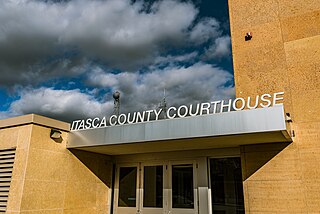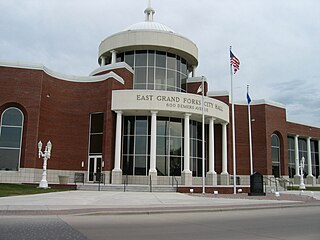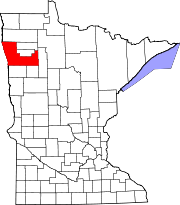
Polk County is a county in the northwestern part of the U.S. state of Minnesota. The population was 31,192 at the 2020 census. Its county seat is Crookston, and the largest community is East Grand Forks.

Beltrami County is a county in the northern part of the U.S. state of Minnesota. As of the 2020 census, the population was 46,228. Its county seat is Bemidji. The county's name comes from Italian adventurer Giacomo Beltrami from Bergamo, who explored the area in 1825. The county was created in 1866 and organized in 1896.

Bemidji is a city and the county seat of Beltrami County, in northern Minnesota, United States. The population was 14,574 at the 2020 census. According to 2022 census estimates, the city is estimated to have a population of 15,946, making it the largest commercial center between Grand Forks, North Dakota and Duluth.
Bemidji Township is a township in Beltrami County, Minnesota, United States. The population was 2,884 as of the 2020 census, down from 3,134 recorded in 2010.

Blackduck is a city in Beltrami County, Minnesota, United States. The population was 845 as of the 2020 census. It is 24 mi (39 km) northeast of Bemidji.
Grant Valley Township is a township in Beltrami County, Minnesota, United States. The population was 2,029 at the 2010 census, up from 1,450 in 2000. Grant Valley Township was named from its location in the valley of Grant Creek.
Northern Township is a township in Beltrami County, Minnesota, United States. The population was 4,657 as of the 2010 census.

Bagley is a city in Clearwater County, Minnesota, United States. The population was 1,285 at the 2020 census. It is the county seat of Clearwater County.

Grand Rapids is a city in Itasca County, Minnesota, United States, and it is the county seat. The population was 11,126 at the 2020 census. The city is named for the 3.5-mile (5.6 km) long rapids in the Mississippi River which was the uppermost limit of practical steamboat travel during the late 19th century. Today the rapids are hidden below the dam of UPM Paper Company.

Argyle is a city in Marshall County, Minnesota, United States, along the Middle River. The population was 544 at the 2020 census. Old Mill State Park is nearby.

Thief River Falls, sometimes referred to as Thief River or abbreviated as TRF, is a city in, and the county seat of, Pennington County in the northwest portion of the U.S. state of Minnesota. The population was 8,749 at the 2020 census.
Badger Township is a township in Polk County, Minnesota, United States. It is part of the Grand Forks-ND-MN Metropolitan Statistical Area. Under the United States Public Land Survey System it is a survey township identified as Township 149 North, Range 42 West, Fifth Principal Meridian. The population was 166 at the 2000 census.

Crookston is a city in the U.S. state of Minnesota. It is the county seat of Polk County. The population was 7,482 at the 2020 census. It is part of the "Grand Forks, ND-MN Metropolitan Statistical Area" or "Greater Grand Forks".
Crookston Township is a township in Polk County, Minnesota, United States. It is part of the Grand Forks-ND-MN Metropolitan Statistical Area. The population was 554 at the 2000 census.

East Grand Forks is a city in Polk County, Minnesota, United States. The population was 9,176 at the 2020 Census, making it the largest community in Polk County.

Fosston is a city in Polk County, Minnesota, United States. It is part of the Greater Grand Forks region. The population was 1,434 at the time of the 2020 census.

Greenbush is a city in Roseau County, Minnesota, United States. The population was 719 at the 2010 census.

St. Hilaire is a city in section 6 of River Falls Township in Pennington County, Minnesota, United States. The population was 273 at the 2020 census.

Area code 218 is a telephone area code in the North American Numbering Plan (NANP) for the northern part of the U.S. state of Minnesota. It is assigned to the largest of Minnesota's original two numbering plan areas (NPAs), although its geographical boundaries have been modified since inception. It comprises roughly the northern half of the state, and includes the cities of Duluth, Hibbing, Brainerd, Bemidji, Fergus Falls, and Moorhead.

U.S. Highway 2 (US 2) is a United States Numbered Highway in northwest and northeast Minnesota, which runs from the Red River at East Grand Forks and continues east to Duluth, where the route crosses the Richard I. Bong Memorial Bridge over the Saint Louis Bay. The route connects the cities of East Grand Forks, Bemidji, Grand Rapids, and Duluth.





















